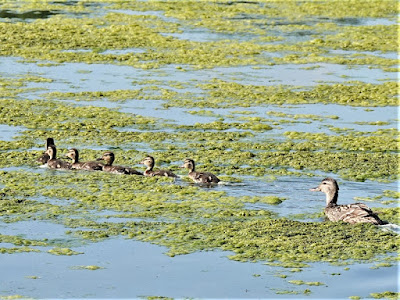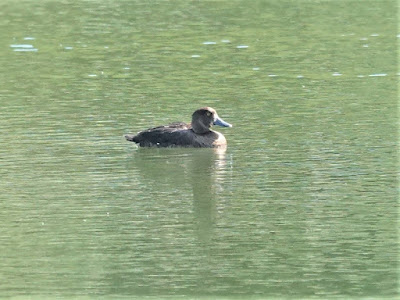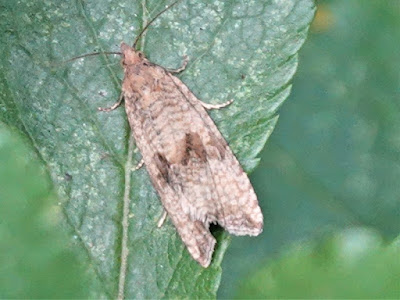11.0°C > 18.0°C: Early wall-to-wall blue gave way to puffy clouds by 09:00. Moderate westerly breeze. Excellent visibility.
Sunrise: 04:52 BST
* = a species photographed today
$ = my first sighting of the species for this year
$$ = my first ever recorded sighting of the species in the area
Priorslee Balancing Lake: 05:00 – 06:15 // 07:35 – 10:00
(163rd visit of the year)
Bird notes
*A puzzling duck this morning which I unsuccessfully tried to turn in to a duck (Greater) Scaup. There is precedent for this species to turn up at this time of year. Sadly today's example turned out to be a duck Tufted Duck with an unusually extensive white area on the face.
Also of particular note was the presence of two species of wader on the same day – that does not often happen. Five *Common Sandpipers stopping off on their return migration were joined briefly by a noisy Oystercatcher.
Other bird notes:
- the Canada and Greylag goslings all still present and correct.
- At least some of the time neither Mute swan was visible.
- four groups of Mallard ducklings seen: a single duckling; a party of six that I am not sure I have seen before; a familiar group of four; and eight well-grown birds probably the erstwhile party of eleven.
- the duck Pochard not seen.
- the Little Grebe not heard.
- the Garden Warbler was not seen or heard.
- another unusual early movement of Jackdaws inbound (northbound) - a group of 73 closely followed by 14 more c.05:35. A small outbound passage of both Jackdaws and Rooks.
- there are still Starlings in the area. Eight were on the roof-railings of academy at c.06:00 with a flight of nine joining them from the estate.
Bird(s) noted flying over here:
- 5 Feral Pigeons
- 89 Wood Pigeons
- 1 Herring Gull
- 6 Lesser Black-backed Gulls
- 4 Cormorants: together and all adults
- 138 Jackdaws
- 28 Rooks
Counts from the lake area:
- 4 + 1 (1 brood) Canada Geese
- 3 + 3 (1 brood) Greylag Geese
- 2 Mute Swans
- *21 (?♂) + 19 (4 broods) Mallard: see notes
- no Pochard
- *1 (0♂) Tufted Duck
- 3 Moorhens
- 89 adult and juvenile Coots
- no Little Grebe
- 9 + >3 (3 broods) Great Crested Grebes again
- 1 Oystercatcher, briefly
- *5 Common Sandpipers
- 2 Black-headed Gulls, briefly and early
- 2 Lesser Black-backed Gulls
- 1 Grey Heron: arrived
Hirundines etc. noted:
- 10 Swifts
- 2 Barn Swallow
- 2 House Martins
Warblers recorded (the figure in brackets is birds noted singing):
- 1 (1) Cetti's Warbler
- 12 (8) Chiffchaffs
- 9 (9) Reed Warblers
- 4 (4) Blackcaps only
- no Garden Warbler
On the West end street lamp poles around-dawn:
Nothing was noted. I'm not doing very well here this year – the lamps at The Flash seem to be performing better.
Noted later:
Butterflies:
*Essex Skipper Thymelicus lineola
Small Skipper Thymelicus sylvestris
Large White Pieris brassicae
Green-veined White Pieris napi
Small White Pieris rapae
Speckled Wood Pararge aegeria
Ringlet Aphantopus hyperantus
Meadow Brown Maniola jurtina
*Gatekeeper Pyronia tithonus
Comma Polygonia c-album
Common Blue Polyommatus icarus: never stopped for a photo!
*Essex Skipper Thymelicus lineola
Small Skipper Thymelicus sylvestris
Large White Pieris brassicae
Green-veined White Pieris napi
Small White Pieris rapae
Speckled Wood Pararge aegeria
Ringlet Aphantopus hyperantus
Meadow Brown Maniola jurtina
*Gatekeeper Pyronia tithonus
Comma Polygonia c-album
Common Blue Polyommatus icarus: never stopped for a photo!
Moths
1 Common Nettle-tap Anthophila fabriciana
*1 Barred Marble Celypha striana
1 Common Marble Celypha lacunana
*1 Double Orange-spot Pammene aurana
1 Pale Straw Pearl Udea lutealis
1 Common Nettle-tap Anthophila fabriciana
*1 Barred Marble Celypha striana
1 Common Marble Celypha lacunana
*1 Double Orange-spot Pammene aurana
1 Pale Straw Pearl Udea lutealis
Bees, wasps etc.:
Common Carder Bee Bombus pascuorum
Buff-tailed Bumblebee Bombus terrestris
*$ Vestal Cuckoo Bee Bombus vestalis [Vestal Cuckoo Bumblebee]
Common Wasp Paravespula vulgaris
Common Carder Bee Bombus pascuorum
Buff-tailed Bumblebee Bombus terrestris
*$ Vestal Cuckoo Bee Bombus vestalis [Vestal Cuckoo Bumblebee]
Common Wasp Paravespula vulgaris
Hoverflies:
Bumblebee Blacklet Cheilosia illustrata [Bumblebee Blacklet]
Marmalade Hoverfly Episyrphus balteatus
Tapered Dronefly Eristalis pertinax
*Migrant Field Syrph Eupeodes corollae [Migrant Hoverfly; Migrant Aphideater]
Meadow Field Syrph Eupeodes latifasciatus [Broad-banded Aphideater]
Tiger Hoverfly Helophilus pendulus
Common Twist-tail Sphaerophoria scripta [Long Hoverfly; Common Globetail]
Syrphus sp. S. ribesii / S. vitripennis
Bumblebee Blacklet Cheilosia illustrata [Bumblebee Blacklet]
Marmalade Hoverfly Episyrphus balteatus
Tapered Dronefly Eristalis pertinax
*Migrant Field Syrph Eupeodes corollae [Migrant Hoverfly; Migrant Aphideater]
Meadow Field Syrph Eupeodes latifasciatus [Broad-banded Aphideater]
Tiger Hoverfly Helophilus pendulus
Common Twist-tail Sphaerophoria scripta [Long Hoverfly; Common Globetail]
Syrphus sp. S. ribesii / S. vitripennis
Dragon-/Damsel-flies:
*Common Blue Damselfly Enallagma cyathigerum [Common Bluet]
Blue-tailed Damselfly Ischnura elegans [Common Bluetail]
many damselflies not specifically identified
also
*$ Black-tailed Skimmer Orthetrum cancellatum
*Common Blue Damselfly Enallagma cyathigerum [Common Bluet]
Blue-tailed Damselfly Ischnura elegans [Common Bluetail]
many damselflies not specifically identified
also
*$ Black-tailed Skimmer Orthetrum cancellatum
Lacewings:
none
none
Other flies:
Scorpion Fly Panorpa sp.: I assumed these were finished – not seen for some days
plus
as usual many unidentified flies of many different species
Scorpion Fly Panorpa sp.: I assumed these were finished – not seen for some days
plus
as usual many unidentified flies of many different species
Bugs:
none
none
Beetles:
7 Spot Ladybird Coccinella 7-punctata
pupae of Harlequin Ladybird Harmonia axyridis: perhaps all empty shells?
*Harlequin Ladybird Harmonia axyridis var. succinea
Pollen Beetle Meligethes sp.
Common Red Soldier Beetle Rhagonycha fulva [Hogweed Bonking-beetle]
7 Spot Ladybird Coccinella 7-punctata
pupae of Harlequin Ladybird Harmonia axyridis: perhaps all empty shells?
*Harlequin Ladybird Harmonia axyridis var. succinea
Pollen Beetle Meligethes sp.
Common Red Soldier Beetle Rhagonycha fulva [Hogweed Bonking-beetle]
Slugs, snails etc.:
White-lipped Snail Cepaea hortensis
White-lipped Snail Cepaea hortensis
Amphibians:
none
none
Spiders, harvestmen etc.:
none
none
New flowers for the year:
None
A Mallard with six duckling. I don't recall seeing this brood before: they look to be well over a week old. Where have they been hiding.
The duck that caused me so much trouble this morning. The extent of the white on her face recalled Great Scaup which would be unlikely but not impossible at this date.
Head shape is an important separation feature and she chose to stay at a point where it was not easy to get close. Here from another angle.
On my final attempt it is just possible to see the slight 'tuft' on the back of the head to confirm this is indeed 'just' a duck Tufted Duck with an unusual amount of white on the face. Perhaps one born this year?
You have to look hard! In front of the three sleeping Mallard are four Common Sandpipers! One with its back to us is in front of the right hand Mallard. The other three are at the left edge of the concrete, two standing and one sitting. Well it is a long way across the width of the lake.
One Common Sandpiper standing proud on some of the weed hauled out of the lake by the sailing club with three (look hard) Mallard sun themselves. The left-most Mallard may look like a duck but the wholly yellowish bill tells us it is a drake going through its moult.
This skipper has no scent mark in the wing so it must be a female. They are difficult to view from head-on to see their antennae's black tip – or not!
A Gatekeeper Pyronia tithonus showing the two white dots in the black circle on the forewing. This is a male with the dark shading on the forewing. In older literature this species is sometimes called Hedge Brown. It likes brambles.
I nearly dismissed this moth a faded and worn Common Marble Celypha lacunana. It isn't: it is the closely-related Barred Marble C. striana.
Obsidentify was 96% certain this is a Vestal Cuckoo Bee Bombus vestalis. Typically cuckoo bees are less hairy than 'ordinary' bumblebees. Is this perhaps too hairy? It was the extensive white 'tail' with faint banding that attracted me. I am still not sure.
A Migrant Field Syrph Eupeodes corollae. Migrant by name but not necessarily a migrant in reality. The small number of over-wintering residents are boosted by large numbers arriving from the continent each year. These then breed such that as the year progresses the proportion of migrants diminishes.
This is a male Common Blue Damselfly Enallagma cyathigerum. Apart from one Blue-tailed Damselfly Ischnura elegans all the damselflies I checked this morning were this species. I cannot separate Azure Damselfly Coenagrion puella from the Common Blue on colour and I rely of the different marking on the first body segment to separate them.
(Ed Wilson)
In the Priorslee Avenue tunnel:
For reasons unknown the tunnel seems to be pug-moth central. Here is a Slender Pug Eupithecia tenuiata: as yesterday.
(Ed Wilson)
The Flash: 06:20 – 07:30
(161st visit of the year)
Bird notes:
- the late brood of two Mallard ducklings seen again.
- yesterday's drake Pochard not seen.
- 14 Tufted Duck noted.
- only one Great Crested Grebes located.
- the Great (White) Egret noted still here.
Bird(s) noted flying over here:
- 5 Jackdaws
Noted on / around the water:
- 166 Canada Geese
- 72 Greylag Geese
- 1 mainly white feral goose
- 6 Mute Swans
- 19 (?♂) + 2 (1 brood) Mallard
- no Pochard
- 14 (10?♂) Tufted Duck: some hard to sex as they moult
- 4 Moorhens again
- 62 + 7 (3 broods) Coots
- 1 Great Crested Grebe
- 1 Great (White) Egret
Hirundines etc. noted:
- 2 House Martins
Warblers recorded (the figure in brackets is birds noted singing):
- 4 (4) Chiffchaffs
- 3 (3) Blackcaps
Noted around the area:
A Mallard with six duckling. I don't recall seeing this brood before: they look to be well over a week old. Where have they been hiding.
You have to look hard! In front of the three sleeping Mallard are four Common Sandpipers! One with its back to us is in front of the right hand Mallard. The other three are at the left edge of the concrete, two standing and one sitting. Well it is a long way across the width of the lake.
Two Common Sandpipers fly of on typically bowed wings. Very harsh lighting today.
Interesting. A skipper butterfly with a short scent gland parallel to the wing edge suggesting an Essex Skipper Thymelicus lineola. I just wish I had been able to get the other side of it to double-check that the underside of the antennae are black.
This skipper has no scent mark in the wing so it must be a female. They are difficult to view from head-on to see their antennae's black tip – or not!
A Double Orange-spot moth Pammene aurana.
Obsidentify was 96% certain this is a Vestal Cuckoo Bee Bombus vestalis. Typically cuckoo bees are less hairy than 'ordinary' bumblebees. Is this perhaps too hairy? It was the extensive white 'tail' with faint banding that attracted me. I am still not sure.
My first Black-tailed Skimmer dragon fly Orthetrum cancellatum of the year.
A Harlequin Ladybird Harmonia axyridis of the form succinea.
(Ed Wilson)
------------------------------------------------------------------------------------------------------
In the Priorslee Avenue tunnel:
Moths:
1 Common Grey Scoparia ambigualis
*1 Slender Pug Eupithecia tenuiata : as yesterday
*1 $ Wormwood Pug Eupithecia absinthiata
1 Common Grey Scoparia ambigualis
*1 Slender Pug Eupithecia tenuiata : as yesterday
*1 $ Wormwood Pug Eupithecia absinthiata
Flies:
10 moth flies Psychodidae sp. [Drain Fly or Owl Fly]
10 midges of various species.
10 moth flies Psychodidae sp. [Drain Fly or Owl Fly]
10 midges of various species.
For reasons unknown the tunnel seems to be pug-moth central. Here is a Slender Pug Eupithecia tenuiata: as yesterday.
While this is my first Wormwood Pug Eupithecia absinthiata for several years.
(Ed Wilson)
------------------------------------------------------------------------------------------------------
The Flash: 06:20 – 07:30
(161st visit of the year)
Bird notes:
- the late brood of two Mallard ducklings seen again.
- yesterday's drake Pochard not seen.
- 14 Tufted Duck noted.
- only one Great Crested Grebes located.
- the Great (White) Egret noted still here.
Bird(s) noted flying over here:
- 5 Jackdaws
Noted on / around the water:
- 166 Canada Geese
- 72 Greylag Geese
- 1 mainly white feral goose
- 6 Mute Swans
- 19 (?♂) + 2 (1 brood) Mallard
- no Pochard
- 14 (10?♂) Tufted Duck: some hard to sex as they moult
- 4 Moorhens again
- 62 + 7 (3 broods) Coots
- 1 Great Crested Grebe
- 1 Great (White) Egret
Hirundines etc. noted:
- 2 House Martins
Warblers recorded (the figure in brackets is birds noted singing):
- 4 (4) Chiffchaffs
- 3 (3) Blackcaps
Noted around the area:
Butterflies:
none
none
Moths [on street lamp poles and in the grass]
1 Garden Grass-moth Chrysoteuchia culmella [was Garden Grass-veneer]
*1 Tortrix moth to be identified
*1 Clouded Border Lomaspilis marginata
*1 Black Arches Lymantria monacha
1 Garden Grass-moth Chrysoteuchia culmella [was Garden Grass-veneer]
*1 Tortrix moth to be identified
*1 Clouded Border Lomaspilis marginata
*1 Black Arches Lymantria monacha
Bees, wasps etc.:
Common Carder Bee Bombus pascuorum
Common Wasp Paravespula vulgaris
Common Carder Bee Bombus pascuorum
Common Wasp Paravespula vulgaris
Hoverflies:
Marmalade Hoverfly Episyrphus balteatus
Migrant Field Syrph Eupeodes corollae [Migrant Hoverfly; Migrant Aphideater]
Marmalade Hoverfly Episyrphus balteatus
Migrant Field Syrph Eupeodes corollae [Migrant Hoverfly; Migrant Aphideater]
Dragon-/Damsel-flies:
none
none
Other flies:
numerous different midges and flies
numerous different midges and flies
Bugs:
none
none
Beetles:
larvae of Alder Leaf Beetle Agelastica alni
pupae of Harlequin Ladybird Harmonia axyridis
Pollen Beetle Meligethes sp.
Common Red Soldier Beetle Rhagonycha fulva [Hogweed Bonking-beetle]
larvae of Alder Leaf Beetle Agelastica alni
pupae of Harlequin Ladybird Harmonia axyridis
Pollen Beetle Meligethes sp.
Common Red Soldier Beetle Rhagonycha fulva [Hogweed Bonking-beetle]
Spiders, harvestmen etc.:
female harvestman Leiobunum blackwalli
female harvestman Leiobunum blackwalli
New flowers for the year:
*$ Chicory Cichorium intybus
I took several photos of this micro-moth. Obsidentify gave me a different answer for each none of which I am happy with. Sot is over to the Shropshire recorder for more help.
One of the smartest-looking moths that I see almost every year is Black Arches Lymantria monacha. Many moths have the 'arches' as part of their vernacular name. It refers to the looping border markings reminiscent of railway arches.
A flower not yet fully open which I believe is Chicory Cichorium intybus. I have probably dismissed this as a garden escape in the past though where I found it – between the two footbridges – is some way from any gardens.
(Ed Wilson)
2012
Priorslee Lake
Grasshopper Warbler reeling
(Ed Wilson)
2006
Priorslee Lake
2 Common Sandpipers
2 drake Ruddy ducks
(Ed Wilson)
*$ Chicory Cichorium intybus
I took several photos of this micro-moth. Obsidentify gave me a different answer for each none of which I am happy with. Sot is over to the Shropshire recorder for more help.
I am on more familiar territory with this Clouded Border moth Lomaspilis marginata I see most years.
(Ed Wilson)
------------------------------------------------------------------------------------------------------
2012
Priorslee Lake
Grasshopper Warbler reeling
(Ed Wilson)
2006
Priorslee Lake
2 Common Sandpipers
2 drake Ruddy ducks
(Ed Wilson)






















